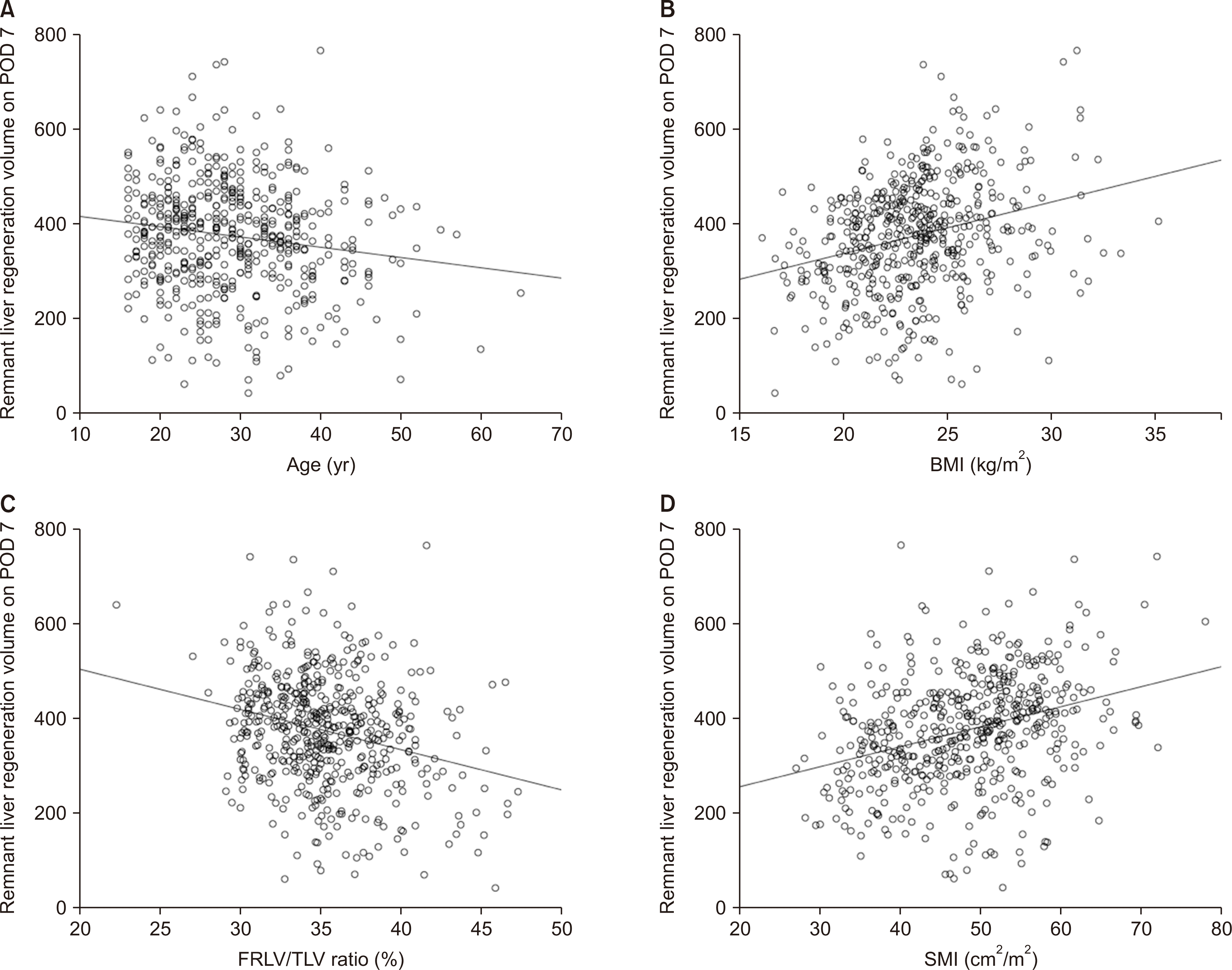1. European Association for the Study of the Liver. 2016; EASL clinical practice guidelines: liver transplantation. J Hepatol. 64:433–85. DOI:
10.1016/j.jhep.2015.10.006. PMID:
26597456.
2. Lee SG. 2015; A complete treatment of adult living donor liver transplantation: a review of surgical technique and current challenges to expand indication of patients. Am J Transplant. 15:17–38. DOI:
10.1111/ajt.12907. PMID:
25358749.
3. Yagi S, Hirata M, Miyachi Y, Uemoto S. 2020; Liver regeneration after hepatectomy and partial liver transplantation. Int J Mol Sci. 21:8414. DOI:
10.3390/ijms21218414. PMID:
33182515. PMCID:
PMC7665117.
4. Olthoff KM, Emond JC, Shearon TH, Everson G, Baker TB, Fisher RA, et al. 2015; Liver regeneration after living donor transplantation: adult-to-adult living donor liver transplantation cohort study. Liver Transpl. 21:79–88. DOI:
10.1002/lt.23966. PMID:
25065488. PMCID:
PMC4276514.
5. Haga J, Shimazu M, Wakabayashi G, Tanabe M, Kawachi S, Fuchimoto Y, et al. 2008; Liver regeneration in donors and adult recipients after living donor liver transplantation. Liver Transpl. 14:1718–24. DOI:
10.1002/lt.21622. PMID:
19025926.
6. Zappa M, Dondero F, Sibert A, Vullierme MP, Belghiti J, Vilgrain V. 2009; Liver regeneration at day 7 after right hepatectomy: global and segmental volumetric analysis by using CT. Radiology. 252:426–32. DOI:
10.1148/radiol.2522080922. PMID:
19703882.
7. Tanemura A, Mizuno S, Wada H, Yamada T, Nobori T, Isaji S. 2012; Donor age affects liver regeneration during early period in the graft liver and late period in the remnant liver after living donor liver transplantation. World J Surg. 36:1102–11. DOI:
10.1007/s00268-012-1496-1. PMID:
22374540.
8. Gruttadauria S, Parikh V, Pagano D, Tuzzolino F, Cintorino D, Miraglia R, et al. 2012; Early regeneration of the remnant liver volume after right hepatectomy for living donation: a multiple regression analysis. Liver Transpl. 18:907–13. DOI:
10.1002/lt.23450. PMID:
22505370.
9. Carey EJ, Lai JC, Sonnenday C, Tapper EB, Tandon P, Duarte-Rojo A, et al. 2019; A North American expert opinion statement on sarcopenia in liver transplantation. Hepatology. 70:1816–29. DOI:
10.1002/hep.30828. PMID:
31220351. PMCID:
PMC6819202.
10. Pravisani R, Soyama A, Ono S, Baccarani U, Isola M, Takatsuki M, et al. 2020; Is there any correlation between liver graft regeneration and recipient's pretransplant skeletal muscle mass? A study in extended left lobe graft living-donor liver transplantation. Hepatobiliary Surg Nutr. 9:183–94. DOI:
10.21037/hbsn.2019.11.08. PMID:
32355676. PMCID:
PMC7188548.
11. Lee J, Kim N, Lee H, Seo JB, Won HJ, Shin YM, et al. 2007; Efficient liver segmentation using a level-set method with optimal detection of the initial liver boundary from level-set speed images. Comput Methods Programs Biomed. 88:26–38. DOI:
10.1016/j.cmpb.2007.07.005. PMID:
17719125.
12. Malladi R, Sethian JA, Vemuri BC. 1995; Shape modeling with front propagation: a level set approach. IEEE Trans Pattern Anal Mach Intell. 17:158–75. DOI:
10.1109/34.368173.
13. Park HJ, Shin Y, Park J, Kim H, Lee IS, Seo DW, et al. 2020; Development and validation of a deep learning system for segmentation of abdominal muscle and fat on computed tomography. Korean J Radiol. 21:88–100. DOI:
10.3348/kjr.2019.0470. PMID:
31920032. PMCID:
PMC6960305.
14. Ikegami T, Nishizaki T, Yanaga K, Shimada M, Kishikawa K, Nomoto K, et al. 2000; The impact of donor age on living donor liver transplantation. Transplantation. 70:1703–7. DOI:
10.1097/00007890-200012270-00007. PMID:
11152100.
15. Kwon KH, Kim YW, Kim SI, Kim KS, Lee WJ, Choi JS. 2003; Postoperative liver regeneration and complication in live liver donor after partial hepatectomy for living donor liver transplantation. Yonsei Med J. 44:1069–77. DOI:
10.3349/ymj.2003.44.6.1069. PMID:
14703618.
17. Ono Y, Kawachi S, Hayashida T, Wakui M, Tanabe M, Itano O, et al. 2011; The influence of donor age on liver regeneration and hepatic progenitor cell populations. Surgery. 150:154–61. DOI:
10.1016/j.surg.2011.05.004. PMID:
21719061.
18. Nakagami M, Morimoto T, Itoh K, Arima Y, Yamamoto Y, Ikai I, et al. 1998; Patterns of restoration of remnant liver volume after graft harvesting in donors for living related liver transplantation. Transplant Proc. 30:195–9. DOI:
10.1016/S0041-1345(97)01229-3. PMID:
9474999.
19. Miyachi Y, Kaido T, Hirata M, Iwamura S, Yao S, Shirai H, et al. 2020; The combination of a male donor's high muscle mass and quality is an independent protective factor for graft loss after living donor liver transplantation. Am J Transplant. 20:3401–12. DOI:
10.1111/ajt.15884. PMID:
32243072.
20. Cruz-Jentoft AJ, Bahat G, Bauer J, Boirie Y, Bruyère O, Cederholm T, et al. 2019; Sarcopenia: revised European consensus on definition and diagnosis. Age Ageing. 48:16–31. DOI:
10.1093/ageing/afy169. PMID:
30312372. PMCID:
PMC6322506.





 PDF
PDF Citation
Citation Print
Print



 XML Download
XML Download